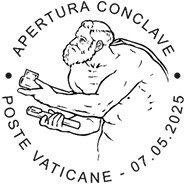
Daily
|
| Christ is giving Peter authority over the Church |
| Peter is surrendering his authority back to Christ |
| The Church is rejecting papal succession |
| The keys represent the Ten Commandments |
Your answer was: Peter is surrendering his authority back to Christ. |
Answer: The Symbolism of the Keys in the 2025 Conclave Postmark  The Vatican’s special postmark dated May 7, 2025, commemorates the opening of the conclave—the sacred gathering of cardinals to elect a new Pope. The design features a powerful reinterpretation of a scene from Michelangelo’s Last Judgment fresco in the Sistine Chapel, where Saint Peter symbolically returns the keys of the Church to Christ. This moment, though not explicitly depicted in the original fresco, is drawn from a theological reading of the transition of papal authority. According to the Vatican’s official description, the keys are “deliberately depicted without rings”, emphasizing that they are not being handed over as a permanent possession, but rather returned—a gesture of humility and submission. This visual metaphor aligns with the moment of sede vacante, when the papal seat is vacant and the Church entrusts itself once again to divine guidance. Artistic and Theological Context Michelangelo’s Last Judgment, painted between 1536 and 1541 on the altar wall of the Sistine Chapel, is a sweeping vision of the Second Coming of Christ and the final judgment of souls. While the fresco does not literally depict Peter handing back the keys, it includes numerous saints and apostles in dynamic, emotionally charged poses. The Vatican’s postmark draws from this visual and spiritual intensity to craft a new symbolic narrative: Peter, the first Pope, relinquishing his mandate to Christ, signaling the Church’s readiness to receive a new shepherd. This interpretation is especially fitting for the conclave, which takes place beneath this very fresco. The cardinals, gathered in solemn prayer and deliberation, are reminded that their authority is not self-derived but entrusted by God. The postmark thus becomes more than a postal mark—it is a theological statement rendered in ink. Sources: Wikipedia - The Last Judgement (Michelangelo) World History Edu - The Last Judgement by Michelangelo Smarthistory - Michelangelo, Last Judgement, Sistine Chapel |